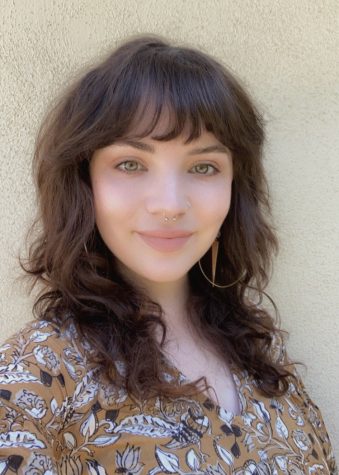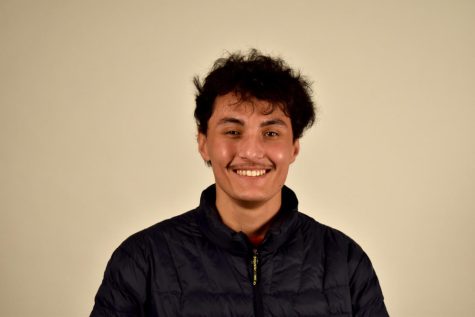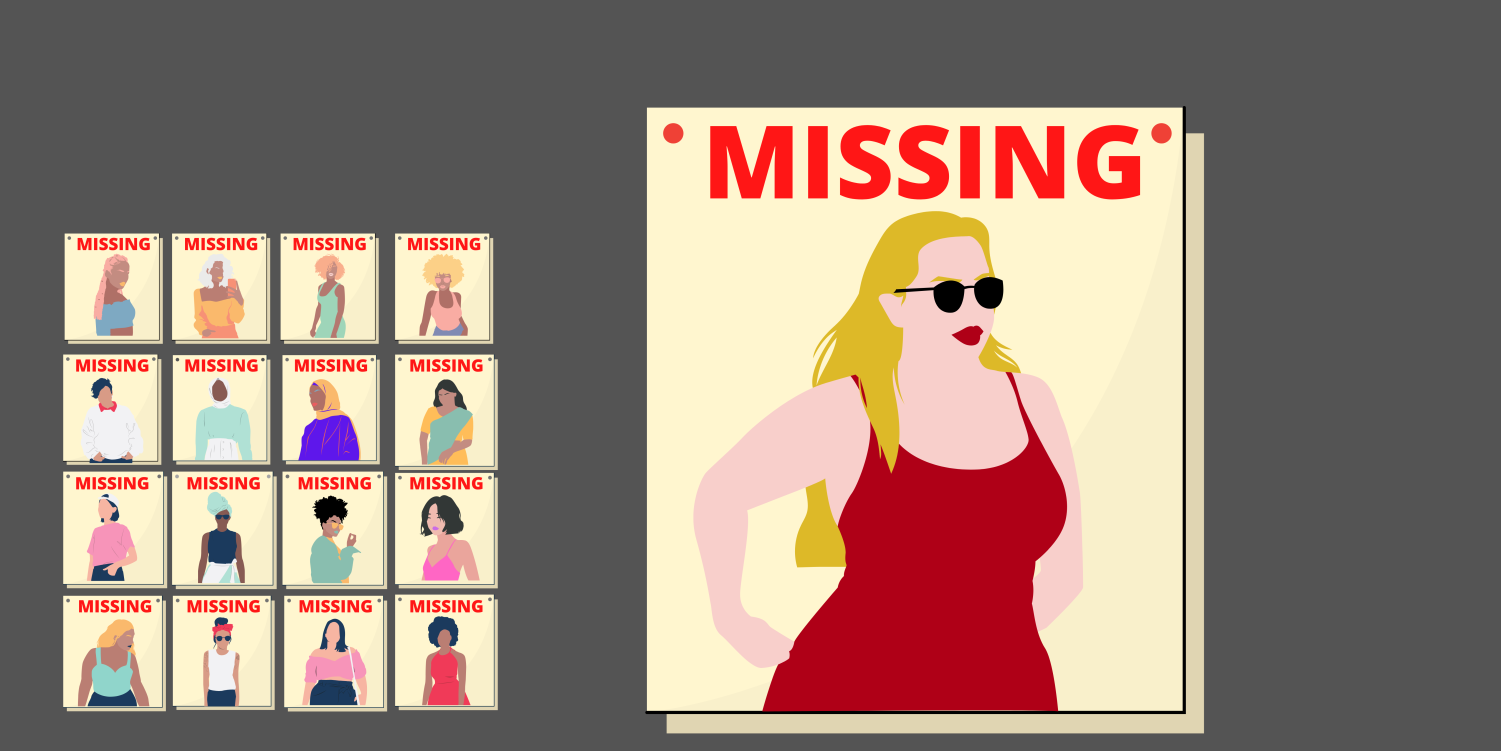



Gabby Petito’s story was one in thousands of Americans who face interpersonal violence every day — disproportionately affecting women of color
October 15, 2021
Outdoorsy. Beautiful. Outspoken for justice. Full of humor.
“Being outdoors and enjoying nature gave her that feeling of empowerment of being free,” a line from her obituary read.
The 23-year-old woman was reported missing by her family after she failed to return home. Weeks later, her remains were discovered in a field in Wyoming.
This wasn’t Gabrielle Petito, who disappeared a month ago and has over 20 million search results associated with her name on Google.
The 23 year old was Jade Wagon, a member of the Northern Arapaho Tribe who went missing from her home on the Wind River Reservation in January 2020. Her death was ruled accidental due to hypothermia and drug intoxication, but her mother, Nicole Wagon, believes that her daughter was a victim of violence. Jade Wagon has 3,610 search results mentioning her name on Google.
While developments on Petito’s case have made national news and retained engagement for weeks running, her story is one of tens of thousands of Americans that experience interpersonal violence every year.
For many like the Wagons, the tide of activism in Petito’s case reaffirmed what was missing for women of color in similar circumstances. The vast majority do not receive widespread media coverage, let alone sizable social media investigation.
Feminist journalist Gwen Ifill originally coined the term “missing white woman syndrome” in 2004, highlighting media’s tendency to favor sensationalized coverage toward white female victims of violence whilst neglecting stories of women of color, who face violence at a disproportionately higher rate, according to the Oregon Coalition Against Domestic and Sexual Violence.
Google Trends data comparing the search terms “Jade Wagon” and “Gabby Petito” visualized the disparity in searches: While searches for Petito leapt beginning at the time of her disappearance, searches for Wagon remained stagnant and silent in the year following her death.
One month ago, 22-year-old Gabrielle Petito was reported missing during a cross-country roadtrip with her boyfriend.
Between Petito’s disappearance on Sept. 11, the discovery of her remains in Wyoming eight days later, and the coroner’s announcement Tuesday declaring her cause of death as stranguation, media coverage of her homicide has garnered national attention.
As of Oct. 13, the TikTok hashtag #TrueCrime has amassed over 6.1 billion views, featuring videos posted across thousands of creator platforms. Since her disappearance about a month ago, posts hashtagged #GabbyPetito jumped to 1.5 billion views.
“We know that there are certain practices that are inherent to the (media) industry that are institutionally racist and sexist, by virtue of the culture in which it was created, and that continues,” said Melissa Camacho, associate professor and instructor of Women and Media within SF State’s Broadcast & Electronic Communication Arts Department.
The state of Wyoming’s Missing and Murdered Indigenous People Task Force reported that over 700 Indigenous women have disappeared between 2011 and 2021, in the same area where Petito went missing. Only 18% of stories of missing and murdered Indigenous women and girls received media coverage.
In comparison, #BreonnaTaylor has accumulated less than half a billion views on TikTok since March 2020, when Louisville police fatally shot her.
A year prior Nicole Wagon lost another daughter and Jade’s elder sister, Jocelyn Watt, 30, when she was shot to death in her home. Watt’s murder remains unsolved.
Women of color [are stereotyped to] exist in communities where there’s already crime and violence and poverty and drugs.
— Marie Drennan
#MMIW, an acronym meant to bring awareness to Missing and Murdered Indigenous Women and the disproportionate violence toward and erasure of Indigenous women, has less than 300 million views on the platform. Jade Wagon and Jocelyn Watt’s stories were not as widely circulated on social media as Petito’s, with no trending hashtags associated with their names.
Marie Drennan, associate professor at SF State’s Broadcast & Electronic Communication Arts Department, related news’ tendency to center white women to tropes that exist within entertainment media: principally, the “damsel in distress.”
“I do think that we hear less about women of color; violence against them, when they go missing, when they’re murdered because there’s also a trope, and a stereotype that white women are protected and safe in the world,” Drennan said. “Women of color [are stereotyped to] exist in communities where there’s already crime and violence and poverty and drugs, and so it’s only natural and to be expected that bad things are gonna happen to them, so when it happens to them it’s not new.”
According to the Department of Justice, one in three Indigenous women will experience sexual violence in their lifetime, and on some reservations, Indigenous women are murdered at a rate more than 10 times the national average.
The FBI had 89,000 active missing persons cases at the end of 2020, 45% of which were people of color. Statistics gathered through the Black and Missing Foundation illustrated that of the 543,018 Americans reported missing in 2020, 57% were white or Hispanic, and 36% were Black.
My kids are not statistics. They were human beings.
— Nicole Wagon
Violence against marginalized women, sex workers, undocumented individuals, and those living within historically disenfranchised communities are often minimized and treated as less newsworthy, according to SF State Department of Women and Gender Studies Professor, Julietta Hua.
“The violence happens in all kinds of places, right, and we should care about it every time — we should all care about when violence happens to anybody, in any community, but we’re not invited to care in that way,” Hua said.
Wagon has continued to advocate justice for her daughters, and commented to The Guardian on the discrepancy between theirs and Petito’s news coverage.
“It makes you feel like we don’t matter; we’re just a statistic,” Wagon said in an interview with The Guardian. “And I’m like, my kids are not statistics. They were human beings. And they had lives. And regardless of what people may think, or assume, they don’t know their stories.”
News and entertainment venues’ decisions to center white victims not only draws attention away from conversations about intimate partner violence and gender-based violence at large, but condition our brains to surmise whose lives are more valuable, Drennan said.
“You know all of this energy around it, and the repetition the repetition the repetition, it’s everywhere that that’s not only drowning out other stories, right? It’s taking up all the oxygen, but it’s also reinforcing how normal it feels to us to have a white woman be the center of attention,” Drennan said.
Repeated exposure to violence and lack of action witnessed by those living in marginalized communities can have lasting impacts on mental health, job security and well-being, according to the American Psychological Association.
A “significant portion” of young people living in areas prone to violence believe they will die before the age of 35, according to the APA report. This believed mortality rate is then correlated with low GPA, increased depressive symptoms, and lower socioeconomic status in adulthood.
Women who experience violence are significantly more likely to have unstable employment than women who do not, and 17% of the cities cited by APA listed domestic abuse as a primary cause of family homelessness.
I’m glad #GabbyPetito’sdisappearance has received so much coverage and there’s been a vigorous investigation. My thoughts are w/her family.
I just want there to be same interest and energy re every disappeared young woman in America – Brown, Black, Native-American, transgender.
— Ana Navarro-Cárdenas (@ananavarro) September 20, 2021
The fault lines of public attention do not fall neatly along separations of race. The location and socioeconomic background of the victim factor into coverage and perceived credibility, according to Evanthia Pappas, managing assistant district attorney for the San Francisco District Attorney’s domestic violence unit.
“There’s a feeling that women who are from poor socioeconomic backgrounds, who do not speak the language, who are transient, who have substance abuse issues, and may even have affected that particular case, that they’re not worth believing — they’re not worth being covered,” Pappas said.
The Rape, Abuse & Incest National Network’s statistics on the National Crime Victimization Survey showed that roughly two thirds of sexual assaults go unreported, with the leading for not reporting being a fear of retaliation and believing that police wouldn’t do anything to help.
While Black women face rates of intimate partner violence 35% higher than white women, they are significantly less likely than white women to use victim services, according to the Bureau of Justice Statistics.
Further nuances exist for queer and trans women experiencing violence, according to Pablo Espinoza, co-executive director at the Community United Against Violence, a San Francisco-based organization with the mission to build the power of LGBTQ+ communities to transform violence and oppression.
Alluding to a video of Petito and Laundrie captured on a Utah police officer’s body camera in August after a reported domestic dispute, Espinoza related the footage to similar experiences in advocating for survivors of intimate partner violence within the queer community.
“It kind of reminded me of so many times that we’ve worked with survivors who were arrested alongside their partner, because the cops didn’t know or couldn’t tell or didn’t really bother to investigate more fully who was doing the abusing and who was surviving it,” Espinoza said.
Trans women are particularly prone to sexual and physical violence, existing at an intersection of gender, race, socioeconomic and transphobia-driven hate, while experiencing homelessness at a higher rate, according to the Human Rights Campaign. In 2021, 38 transgender and gender nonconforming people have been killed, their deaths recieving little or misrepresentative media coverage.
On Jan. 28, 21-year-old Fifty Bandz of Baton Rouge, Louisiana, was shot to death by Michael Joshua Brooks, 20, a former romantic partner who’d previously threatened her life, according to local news coverage that deadnamed her in their coverage. Bandz was at least the fifth transgender person killed in 2021, according to the HRC, with four out of the five victims being Black transgender women.
“In the late ’90s, when CUAV was tracking that transgender women were being murdered or gone missing at a rate of 1-2 per month, only those close to trans communities knew this was happening, and larger groups and media paid very little to no attention,” Espinoza later wrote in an email to Xpress.
Camacho added that more can be done to equip viewers with media literacy to examine underlying institutional issues behind single instances of violence, and learn to differentiate between news and entertainment media.
“The first part of change is to recognize and acknowledge that the problem exists, and we’re still at that point,” Camacho said.
If you or a loved one are experiencing emotional, sexual or physical violence, you are not alone and there are resources available to you.

